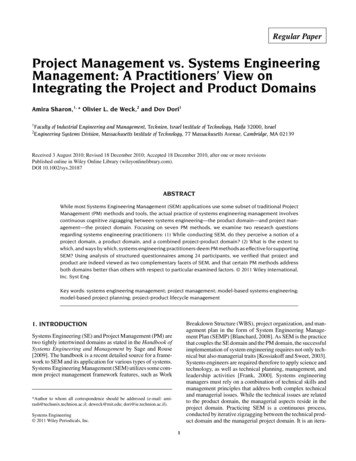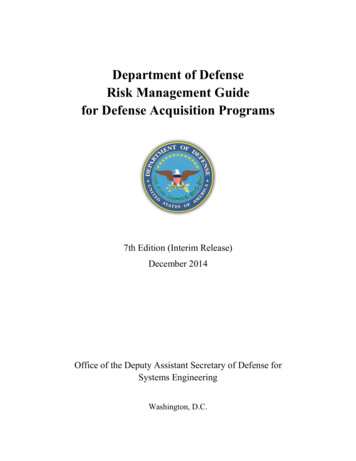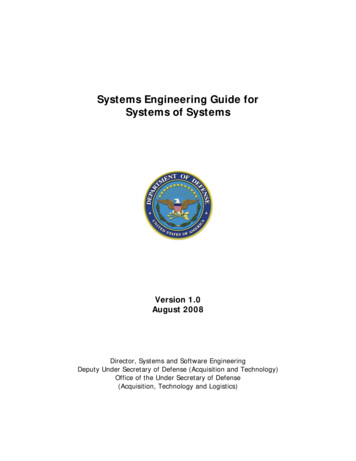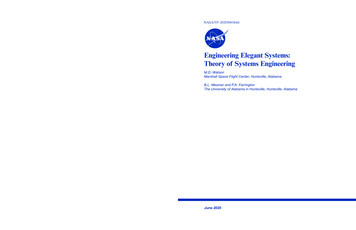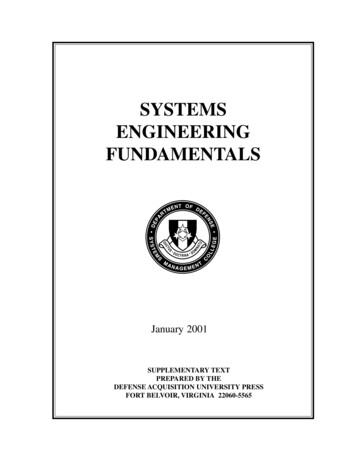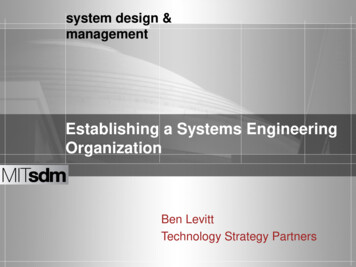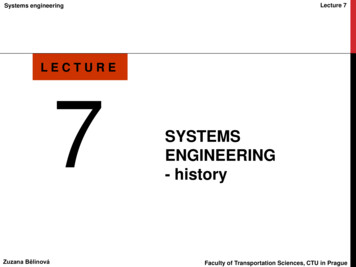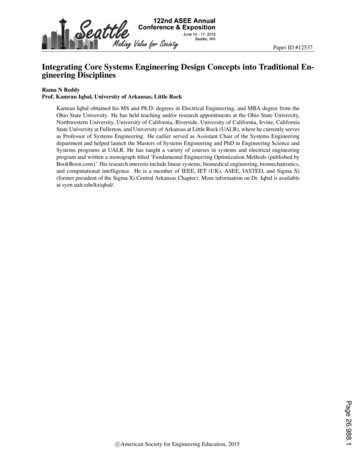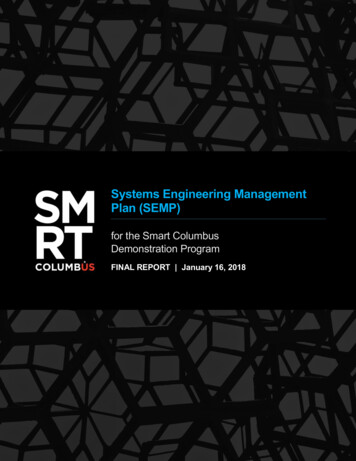
Transcription
Systems Engineering ManagementPlan (SEMP)for the Smart ColumbusDemonstration ProgramFINAL REPORT January 16, 2018
Produced by City of ColumbusNoticeThis document is disseminated under the sponsorship of the Department of Transportationin the interest of information exchange. The United States Government assumes no liabilityfor its contents or use thereof.The U.S. Government is not endorsing any manufacturers, products, or servicescited herein and any trade name that may appear in the work has been includedonly because it is essential to the contents of the work.Acknowledgement of SupportThis material is based upon work supported by the U.S. Department ofTransportation under Agreement No. DTFH6116H00013.DisclaimerAny opinions, findings, and conclusions or recommendations expressed in thispublication are those of the Author(s) and do not necessarily reflect the view of theU.S. Department of Transportation.
Version HistoryVersion #DateAuthor(s)Reviewer(s)Summary of ChangesFinal v1.04/28/17HNTBHNTBAdd draft risk register andrequirements verificationmatrixFinal v1.15/12/17HNTBFHWA508 formattingDraft v2.011/8/17HNTBCity of ColumbusModified based on updated PMPand Project Advancement Approach.Draft v2.211/22/17HNTBCity of ColumbusScrum EditingDraft v2.311/30/17HNTBCity of ColumbusCombined chapter assignments andcommentsDraft v2.412/1/17HNTBCity of ColumbusFull review of all chapters combinedDraft v2.512/6/17HNTBCity of ColumbusFinal DraftFinal12/8/17City ofColumbusUSDOTFinal to USDOTFinal –Revised1/16/18City ofColumbusUSDOTRevised per USDOT commentsFinal v35/10/19City ofColumbusCity of ColumbusRevised FormattingSystems Engineering Management Plan – Final Report Smart Columbus Program i
Table of Contents1.1Scope of the Systems Engineering Management Plan . 11.2Intended Audience . 11.3SEMP Update Process . 21.4Relation to the PMP . 21.5Overview of the Document . 32.1Strategic Framework . 52.2Program Overview . 72.2.1Project Descriptions . 73.1Engineering Plan Oversight/Roles & Responsibilities . 113.2Program Level System Engineering Approach . 193.2.13.2.23.2.3System of Systems. 19Scrum of Scrums . 22Smart Columbus Operating System (SCOS) . 253.3Program Dependencies and Integration . 263.4Project-Level System Engineering Approach . 283.4.13.4.23.4.34.1Project Advancement Approach. 28Project Advancement Initiation (ConOps, User Needs, Trade Studies) . 31Acquisition Evaluation Factors . 33Development Methodology . 354.1.14.1.24.1.34.1.4V-Model . 35Agile. 39Existing Solutions. 44V – Pivot to Agile . 454.2Considerations For Adopting V-Model or Agile Methodology. 455.1Program Documentation Management Plan/Archive . 495.2Program Documentation . 50Systems Engineering Management Plan – Final Report Smart Columbus Program iii
Table of Contents5.2.15.2.25.2.35.3System of Systems ConOps . 50System Architecture and Standards Plan . 50Demonstration Site Map and Installation Schedule . 51Project-level Documentation . 515.3.15.3.2V-Model Documentation . 52Agile Documentation . 575.4Documentation Review Process . 605.5Interface Control Process . 615.5.1Program Dependencies . 61List of TablesTable 1. Project Outcomes . 6Table 2. Project Product/Business Owners . 11Table 3. Engineering Oversight – Roles and Responsibilities . 12Table 4. Description of Project Advancement Steps . 29Table 5. Project Evaluation Criteria . 31Table 6. Summary of Project Evaluations . 32Table 7. V-Model Key Roles and Responsibilities . 36Table 8. Scrum Key Roles and Responsibilities. 40Table 9. Description of Workflow Stages . 43Table 10. Primary Considerations for Assessing V-Model vs Agile Development Methodologies . 46Table 11. Detailed Consideration for Assessing V-Model vs Agile Development Methodologies . 47Table 12. V-Model Process Tools . 52Table 13. V-Model Artifacts. 53Table 14. Agile Tools . 57Table 15. Agile Artifacts . 58Table 16. Dependency Structure Matrix . 62Table 17: Acronym List . 63Table 18: Requirements Verification Traceability Matrix (RTVM) . 69Table 19: Project Evaluation Matrix . 71iv Smart Columbus Program Systems Engineering Management Plan – Final Report
Table of ContentsList of FiguresFigure 1. Smart Columbus Framework . 8Figure 2. Smart Columbus PMO Structure . 18Figure 3. Overall System Engineering Approach . 20Figure 4. Scrum of Scrum Teams. 24Figure 5. SCOS Open System Interconnection Diagram . 25Figure 6. Smart Columbus Program-Level Context Diagram . 27Figure 7. Project Advancement Process . 29Figure 8. V-Diagram . 37Figure 9. Smart Columbus Scrum Software Development Workflow . 42Figure 10. V-Model Methodology Documents . 54Figure 11. Document Review and Approval Process Flow . 60Systems Engineering Management Plan – Final Report Smart Columbus Program v
IntroductionThe Smart Columbus program is an integrated and holistic demonstration that will help all residents havemore mobility options and access opportunities. The program consists of nine projects which are describedin the Smart Columbus Project Management Plan (PMP) and later in this document. The Smart Columbusprogram will demonstrate how advanced technologies can be integrated into other operational areas withinthe City, utilizing advancements in intelligent transportation systems (ITS) and connected vehicles (CV),automated vehicles (AV), and electric vehicles to meet these challenges, while integrating data from varioussectors and sources to simultaneously power these technologies while leveraging the new information theyprovide.To be successful, the program requires a rigorous, well-defined, and holistic Systems Engineering Process(SEP) to support the planning, design, deployment, operations, and maintenance of the ITS and advancedtechnology projects that will be demonstrated. These projects will be deployed together in the City ofColumbus as a cohesive, integrated system-of-systems to meet public and stakeholder needs.1.1SCOPE OF THE SYSTEMS ENGINEERING MANAGEMENT PLANThe scope of this System Engineering Management Plan (SEMP) is to document the SEP the City ofColumbus will follow to deliver a successful Smart Columbus program. The SEMP enables the SmartColumbus Program Office to manage the overall Smart Columbus program and each of its associatedprojects using consistent systems engineering principles and methodologies to maximize the quality of eachsystem while adhering to the scope, budget, and schedule. Benefits of having a well-defined SEP include:1.2 Improved stakeholder participation More adaptable, resilient, and interoperable systems Verified functionality and fewer defects Replicability and continuity with subsequent projects Better documentation1INTENDED AUDIENCEThe Smart Columbus program team includes staff from the United States Department of Transportation(USDOT), the City of Columbus, their contractors, partners, and stakeholders, and independent evaluationteams. This SEMP is intended to provide the entire Smart Columbus team with detailed informationregarding the systems engineering activities at both the program and individual project level, specificallydiscussing: 1The process to manage the relationship between program and project objectivesThe project sequence and dependenciesThe identification of common tsguide/section2.htm#s2.1Systems Engineering Management Plan – Final Report Smart Columbus Program 1
Chapter 1. Introduction The management hierarchy between program and projectsThe SEMP identifies resources, processes, and methodologies that can be referenced by the USDOT,Program Managers (PgMs) and Project Managers (PMs) to quickly identify the right team structure,process, documentation, and deliverables, as well as the interdependencies among them.1.3SEMP UPDATE PROCESSThe Smart Columbus SEMP will be a living document. As the program evolves and the team acts on thedescribed activities and process, some elements may require refinement to ensure a quality and sustainablesystem is deployed. The SEMP will be updated as needed to accommodate these changes and refinementsto ensure that the Smart Columbus project team understands and continues to follow SE processes that willresult in successful program outcomes. This document will be reviewed quarterly to maintain alignment withthe PMP and reflect the decisions made during major milestones in the Concept of Operations (ConOps),System Requirements (SyRS), procurement, design, testing and deployments. As the second revision of theSEMP, this document has been reorganized to reflect the latest PMP (November 2017) as well as theProject Advancement Approach discussed with USDOT.1.4RELATION TO THE PMPThe SEMP describes the technical activities; specifically, the SE processes, responsibilities, andmethodologies used on the projects and the relationship of these activities to other project activities. ThePMP is the overall master planning document for the Smart Columbus program and includes manydisciplines beyond SE. The PMP is a formal document used to manage project execution. The PMPdocuments the actions necessary to define, prepare, integrate and coordinate the various planningactivities. The PMP defines how the project is executed, monitored and controlled, and closed. The PMPdescribes all activities, including technical activities, to be integrated and controlled during the life of theprogram. The SEMP outlines the technical plans and systems engineering activities that will be used todevelop, integrate, test, validate and deploy the Smart Columbus projects. Developed early in the SEprocess as a supplement to the PMP, the SEMP uses the foundation laid by the PMP to build the frameworkfor executing the SE technical tasks for the program and individual projects.Both documents are important in terms of understanding and managing the scope of work, how to plan forcritical activities, how to manage efforts while reducing risk, and how to successfully complete deliverables.The SEMP must be consistent and evolve in concert with the PMP. They must complement each other andbe cross-referenced. They should consistently define the roles and responsibilities of the technical andmanagement staff, the processes for planning and monitoring technical activities, and identifying andmitigating program and technical risk. The main difference is that the PMP includes all activities to beintegrated and controlled during the life of the program, whereas the SEMP emphasizes the SE activitiesthat are important to the program and individual projects.The City Program Manager (PgM) and Consultant PgM will resolve differences between the PMP and theSEMP on a case by case basis to determine which document takes precedent. Changes to either documentwill be logged as they are identified and incorporated into the next quarterly update to the appropriatedocument.2 Smart Columbus Program Systems Engineering Management Plan – Final Report
Chapter 1. Introduction1.5OVERVIEW OF THE DOCUMENTThe document is organized to provide the SE management approach at both the program and project level.This approach is anchored by regular project-level coordination meetings to maintain project progress andregular program-level Scrum of Scrum2 meetings (see Section 3.2.2 below) to ensure the projects areintegrated and all dependencies are discovered, tracked, and considered during development of the program.The USDOT encourages the use of SE as a structured approach to successfully complete ITS projects3. SEreduces the risk of schedule and cost overruns and increases the likelihood that the implementation will meetthe user's needs.Given the value of the structured approach, the SEMP for the Smart Columbus program will: Outline the framework for all SE tasks associated with the program Provide the technical plan of the program and the processes used to accomplish it Provide detail regarding the engineering tasks, especially detailed information on the processes tobe used for gathering and preparing user needs, defining requirements, etc. Identify the needed tasks (including analysis tasks) and any constraints on the performance of atask (such as use of a specific SE and design methodology)The SEMP begins with an overview of the program (updated as of September 2017), and provides anoverview of how the engineering activities at the program level will be managed. The document also detailshow each of the projects relate, contribute and integrate to the Smart Columbus program, and how the userneeds for each will be will be evaluated and completed before moving into the design and developmentactivities. Finally, the SEMP summarizes how all SE activities will be documented at both the program andproject level.“Scrum” is defined in this document, Section 4.1.2.1. Scrum is an Agile team-based process guided by individuals andinteractions over processes and tools, working software over comprehensive documentation, customer collaboration overcontract negotiation and responding to change over following a plan.3 cfr0940.htm2Systems Engineering Management Plan – Final Report Smart Columbus Program 3
Smart Columbus Scope and Goals2.1STRATEGIC FRAMEWORKThe Smart Columbus vision strives to empower residents to live their best lives through responsive,innovative, and safe mobility solutions with a supporting mission to demonstrate how ITS and equitableaccess to transportation have positive impacts on every day challenges faced by cities. The PMP articulatesfour outcomes of the Smart Columbus program, including: Improve Safety: The City of Columbus wants to create safer streets where vehicles, cyclists, andpedestrians are less likely to be involved in accidents. Enhance Mobility: The City of Columbus wants to make traversing the City and parking as efficientand convenient as possible. Enhance Access to Opportunities & Services: The City of Columbus wants to make multi-modaltransportation options and the ability to access them equally available to all residents, especiallythose who need access to opportunities related to health care, jobs, school, and training. Reduce Environmental Impact: The City of Columbus wants to reduce the negative impacttransportation has on the environment through becoming more efficient and embracing multi- modaloptions.Additionally, the draft Performance Measurement Plan provides two outcomes applicable to the projectsbeing developed as part of the demonstration, identified as: Agency Efficiency: Columbus wants to provide tools and access to the data generated by theprojects to improve operations and efficiency of city services. Customer Satisfaction: Columbus wants to provide resources and information to the citizens toincrease their satisfaction with city services through the use and application of technology.These additional outcomes especially relate to the potential impact of the Smart Columbus OperatingSystem (SCOS) and the overall Smart Columbus vision to empower residents (customers). As part of thenext quarterly PMP update, a consolidated list of all outcomes will be provided to be consistent among thePMP, SEMP, and future deliverables such as the Performance Measurement Plan (PfMP).Table 1 below identifies the relationship between the various demonstration projects and the potentialoutcomes. The outcomes will be evaluated based on the PfMP.Systems Engineering Management Plan – Final Report Smart Columbus Program 5
Chapter 2. Smart Columbus Scope and Goals2. ConnectedVehicleEnvironmentXCustomerSatisfaction1. Smart ColumbusOperating MobilitySMARTCOLUMBUSPROJECTSSafetyTable 1. Project OutcomesXXXX3. Multi-Modal TripPlanningApplication/Common Payment SystemXX4. MobilityAssistance forCognitiveDisabilitiesXXXX5. Prenatal TripAssistanceXXXX6. Smart MobilityHubsXX7. Event ParkingManagementX8. ConnectedElectric AutomatedVehicleX9. Truck PlatooningTotalXXX28XXXXXXX536 Smart Columbus Program Systems Engineering Management Plan – Final Report38
Chapter 2. Smart Columbus Scope and Goals2.2PROGRAM OVERVIEWSmart Columbus is taking a district-oriented approach to best demonstrate effective implementation of acomprehensive portfolio of connected technologies that solve focused, relatable city issues and enhancemobility across the region. Four deployment districts were strategically identified based on the uniqueproblem-solving proving ground they offer which creates a foundation of nationwide scalability. The districtsare identified below, while the PMP contains a detailed description of each one.1. Residential (Linden)2. Commercial (Easton)3. Downtown4. Logistics (Rickenbacker International AirportThe district/project deployment maps are shown in Figure 2 of the PMP. While there are unique and distinctdeployment districts, many projects will also be deployed citywide and be designed in an integrated mannerwith the SCOS being the integral backbone and heart of all current and future smart city projects.The eight other Smart Columbus projects fit into three overarching themes. As with the districts, a detaileddescription of these themes is contained in the PMP. Enabling Technologies: These technologies leverage today’s foundation in new and innovativeways to greatly enhance the safety and mobility of the transportation infrastructure. Enhanced Human Services (EHS): These services encompass meeting human needs through theapplication of technology that focuses on prevention as well as remediation of problems. Emerging Technologies: New technologies that are currently developing or will be developed over thenext five to ten years, that may substantially alter the business and social environment.2.2.1 Project DescriptionsFigure 1 summarizes the SCOS and portfolio of USDOT projects. It depicts the essential nature of theSCOS and ties the three themes, as well as their supporting projects, together. It also indicates thedocumentation and management of the overall program, anchored by the tools and documentation used incoordination and cooperation between the City and USDOT. Program-level documents including the PMP,SEMP and Performance Measurement Plan (PfMP) – among others – are included under “programmanagement tools and deliverables.”2.2.1.1SMART COLUMBUS OPERATING SYSTEMThe SCOS is envisioned as a web-based, dynamic, governed data delivery platform built on a federatedarchitecture that is at the heart of the Smart Columbus system. It will ingest and disseminate data whileproviding access to data services from multiple sources and tenants, including the planned Smart Columbustechnologies, traditional transportation data and data from other community partners, such as food pantriesand medical services. The SCOS will embody open-data, best-of-breed technologies including open-sourceand commercial off-the-shelf concepts that enable better decision-making and problem solving for all users.It will support a replicable, extensible, sustainable data delivery platform. The SCOS will be the source forperformance metrics for program monitoring and evaluation, serve the needs of public agencies,researchers and entrepreneurs, and assist health, human services organizations, and other agencies inproviding more effective services to their clients. The SCOS will be scalable and demonstrate the potentialfor serving city and private sector needs well beyond the life of the Smart City Challenge (SCC) Awardperiod.Systems Engineering Management Plan – Final Report Smart Columbus Program 7
Chapter 2. Smart Columbus Scope and GoalsSource: City of Columbus, October 2017Figure 1. Smart Columbus Framework2.2.1.22.2.1.2.1ENABLING TECHNOLOGIESConnected Vehicle EnvironmentThere are corridors and intersections in Columbus that have high crash numbers with vehicles, bicyclists,and pedestrians. In addition, there are several congested corridors that result in poor mobility conditions foremergency vehicles, freight, and transit buses. The CVE corridors were selected based on regional crashdata, enhanced transit services, recent infrastructure investments, and relationship to other projects. Forexample, the CVE corridors have 17 intersections in the top 100 regional high-crash intersections.The anticipated outcomes of the CVE project are to enhance safety and mobility throughout the City'stransportation system using CV technologies and applications with an emphasis on congested and highcrash intersections and corridors. Safety applications are intended to be installed on multiple vehicle typesincluding transit buses, first responder vehicles, city, and partner fleet vehicles and private vehicles.Applications will be deployed to ensure the Central Ohio Transit Agency (COTA) Bus Rapid Transit (BRT)fleet can utilize signal prioritization when needed to ensure safety and customer satisfaction.2.2.1.32.2.1.3.1ENHANCED HUMAN SERVICESMulti-modal Trip Planning Application/Common Payment SystemColumbus residents and visitors do not have access to a system for seamless planning of or paying for a tripinvolving multiple transportation service and parking providers. Moreover, some Columbus residents areunbanked and therefore cannot access alternative modes of transportation, including car and bike sharingsystems. The Multi-modal Trip Planning Application (MMTPA) will make multi-modal options easily accessibleto all by providing a robust set of transit and alternative transportation options including routes, schedules, and8 Smart Columbus Program Systems Engineering Management Plan – Final Report
Chapter 2. Smart Columbus Scope and Goalsdispatching possibilities. The application will allow travelers to request and view multiple trip itineraries andmake reservations for shared-use transportation options such as bikeshare, transportation networkcompanies, and car share. Using the MMTPA, users will be able to compare travel options across modes,plan, and pay for their travel based upon current traffic conditions and availability of services. Payment fortransportation service and parking providers will be processed through a Common Payment System (CPS)that may be the first of its kind in the United States. It is the City’s goal that this application will allow residentsto more easily access the transportation systems available in Columbus today and in the future. This project isanticipated to provide an innovative solution to improve mobility and access to opportunity.2.2.1.3.2Mobility Assistance for People with Cognitive DisabilitiesMobility assistance is needed to provide more independence to residents with cognitive disabilities. Personswith cognitive disabilities who wish to independently use public transit services in Columbus must either qualifyfor special paratransit services in accordance with federal law, or they must be sufficiently independent tosafely use fixed route bus service without assistance. The City’s goal is to develop and deploy an applicationthat would allow this population to independently traverse the City via COTA’s fixed bus route system. Themobile application will be a highly-accurate, turn-by-turn navigator designed to be sufficiently intuitive such thatolder adults and groups with disabilities, including the cognitively and visually disabled, can travelindependently.This project provides an opportunity for users to empower themselves and gain mobility independence, relyingless on caregivers or COTA paratransit system for transportation.2.2.1.3.3Prenatal Trip AssistanceColumbus has one of the highest infant mortality rates in the country, which is partially caused by expectantmothers not getting necessary prenatal healthcare. The existing Non-Emergency Medical Transportation(NEMT) system does not always provide reliable round-trip transportation. Linden residents have challengesaccessing healthcare services due to the current NEMT model and technologies. It is the City’s goal to workwith Franklin County and Celebrate One to develop a means for bridging the gap among healthcare providers,expectant mothers, and NEMT services that are paid f
1.1 SCOPE OF THE SYSTEMS ENGINEERING MANAGEMENT PLAN The scope of this System Engineering Management Plan (SEMP) is to document the SEP the City of Columbus will follow to deliver a successful Smart Columbus program. The SEMP enables the Smart Columbus Program Office to manage the overall Smart Columbus program and each of its associated
